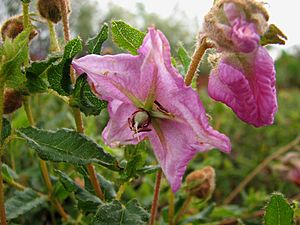Large-flowered thomasia facts for kids
Quick facts for kids Large-flowered thomasia |
|
|---|---|
 |
|
| Scientific classification | |
| Genus: |
Thomasia
|
| Species: |
grandiflora
|
Thomasia grandiflora, also known as large-flowered thomasia, is a special plant found only in the south-west part of Western Australia. Its beautiful pinkish-purple flowers look like paper and hang down from where the leaves meet the stem. The outer parts of the flower, called the calyx, are quite big and stand out more than the actual petals.
About the Large-Flowered Thomasia Plant
Thomasia grandiflora is a small shrub that usually grows to be about 1 m (3 ft 3 in) tall and wide. Its leaves are a bright, dark green. They can be heart-shaped or sometimes a bit narrower. The leaves are slightly flexible and feel leathery. They are typically about 15–25 mm (0.59–0.98 in) long.
The flowers have wide, noticeable pinkish-purple parts called calyx lobes. These are even bigger than the petals themselves. The calyx is thicker near its middle vein. The actual petals are small and often covered with tiny, star-shaped hairs. Sometimes, they only have a few scattered hairs. The flowers feel like paper and are about 2 cm (0.79 in) across. They hang down on short stalks. After the flowers, the plant grows small capsules. These capsules hold black seeds that fall off when they are ready. You can see this plant flowering from winter through spring.
How the Large-Flowered Thomasia Got Its Name
The plant Thomasia grandiflora was first officially described by a botanist named John Lindley in 1839. He wrote about it in a book called A sketch of the vegetation of the Swan River Colony.
The second part of its scientific name, grandiflora, comes from two Latin words. "Grandis" means "large" or "great," and "flos" means "flower." So, the name grandiflora simply means "large-flowered," which describes the plant's big flowers.
Where Large-Flowered Thomasia Grows
The large-flowered thomasia is a common plant found in many places. It mostly grows near the coast in open forests. You can find it throughout the south-west region of Western Australia.

